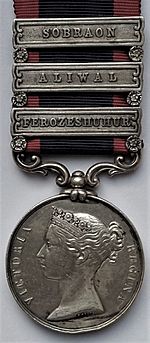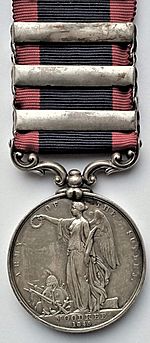Sutlej Medal facts for kids
The Sutlej Medal was a special award given to soldiers in 1846. It was for officers and men from the British Army and the Honourable East India Company. They received it for their service in the Sutlej campaign, which happened from 1845 to 1846. This war is also known as the First Anglo-Sikh War. This medal was important because it was the first time that special "clasps" were used. These clasps showed which major battles a soldier had fought in during the campaign. The medal was officially approved on April 17, 1846.
Contents
What the Medal Looks Like
The Sutlej Medal is a round silver medal, about 36 millimetres (1.4 in) across. It was designed by a famous artist named William Wyon.
Front of the Medal
On the front, you can see the head of Queen Victoria wearing a crown. Around her head, it says "VICTORIA REGINA," which means "Queen Victoria" in Latin.
Back of the Medal
The back of the medal shows a standing figure of Victory, who is like a goddess of winning. She is holding a wreath, which is a symbol of success. At her feet, there are some trophies, like captured weapons. Around the edge, it says "ARMY OF THE SUTLEJ." Below this, it has the name and year of the first big battle the soldier fought in.
Details and Ribbon
- The name of the soldier and their army unit were carved into the edge of the medal.
- The ribbon for the medal is about 31.7 millimetres (1.25 in) wide. It is dark blue with bright red edges.
Special Clasps for Battles
The Sutlej Medal was given for four important battles. The first battle a soldier fought in was written on the back of their medal. If they fought in more battles, they received special metal bars called "clasps" to attach to the medal's ribbon.
There was no clasp for the battle of Moodkee because it was the first battle of the campaign. The three clasps that were awarded were for these battles:
- Ferozeshuhur
- Aliwal
- Sobraon




